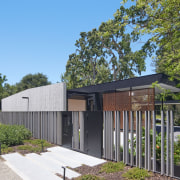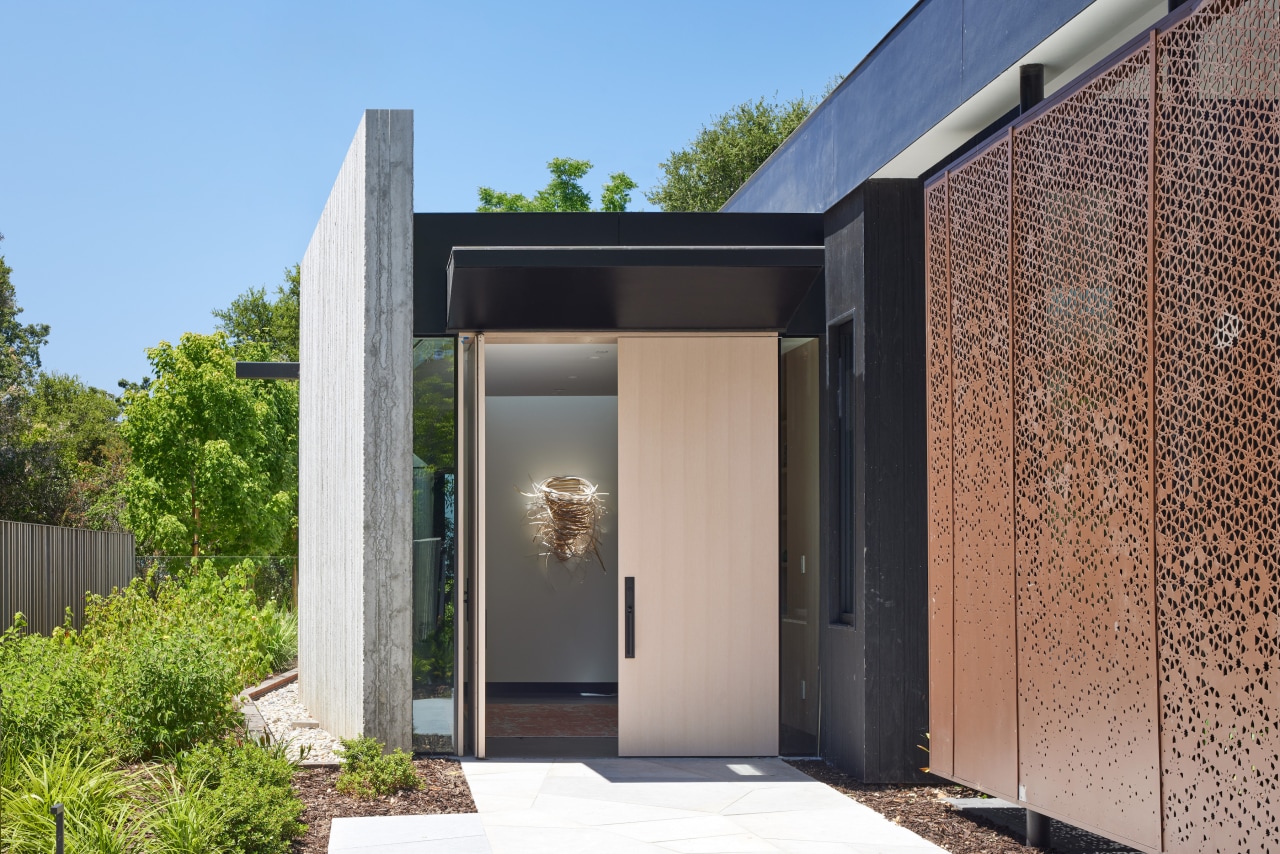All quiet on the street-facing front
This house sidles up to its noisy street frontage, creating spacious courtyard living at rear – the acoustic front fence/facade blocks unwanted sound
Designed by S^A | Schwartz and Architecture
From the architects:
To quieten a noisy road
To quiet a noisy road, this 350m² new home in the heart of the Bay Area’s Silicon Valley turns inward to create an urban cloister buffered from the surrounding city.
Although closed off from the adjacent busy intersection (and the seemingly incessant whistle of the soccer coach at the school across the road), the interior life of this courtyard home remains open and expansive feeling.
The siting of the home at the front edge of the corner lot is somewhat counterintuitive.
Turning its back on the street
Instead of shirking from the noise to the farther reaches of the site – and thereby creating a large front yard of limited value – the architects sidle the structure up to the street and turn its back to it.
With the help of an acoustical engineer, they carefully measured the decibel levels across the site to identify an acceptable target noise level for the family of four.
Reverse engineered
The designers then reverse engineered the design challenge by first asking what length, height and material for an acoustic wall would achieve the desired sound levels behind the barrier.
The answer became the 4.3m tall board-formed concrete wall that both anchors the home on the site and is ever-present on the interior.
Because a free-standing concrete wall was not acceptable to the town’s city planners, the architects realised the structure had to be incorporated as part of the home itself.
Part of the home itself
To then mitigate what could have been an entirely one-sided home for light and views, they created small courtyards between the acoustic wall and the living spaces.
The 'Skyspaces' of the light artist James Turrell inspired the abstract way the courtyard roofs framed the ever-changing sky.
In the end, the house becomes a complex three-sided open courtyard home with a series of smaller courtyards creating additional pockets of space, only hinted at on the exterior.
Needless-to-say, as the acoustic wall rose, so too did the dismay of the neighbours in this traditional neighbourhood of older homes and newer bloated McMansions.
Context quells complaints
As the digital vigilantism swelled, the architects just hoped enough of the rest of the home could rise to give the wall some needed context.
The delays and exacerbated fears of house-bound neighbours due to the pandemic did not help allay concerns for the future of the neighbourhood.
Of course, as with many modern structures, once complete, the home has been embraced; in fact, it has become the go-to teenage hang-out after soccer practice across the road.
Ephemeral nuances of light
On a more conceptual level, to compensate for the loss of sound and view inherent in the architect’s strategy, they focused every element of the design to intensify the ephemeral nuances of natural light over the course of the day.
To capture this, every space looks through a series of layered indoor and outdoor adjacent spaces, each with its own quality of light – thus dramatically increasing the sense of depth and scale in the relatively small site.
For the architects, the leitmotif of the project was the commitment that the loss of one sense should always be balanced out with heightening the perceptions of another.
Compensating one sense for another
To keep their aim true throughout the design process, they held tight to their research on the mechanisms of trans-modal neuroplasticity, which describes the brain's process of compensating for a deficit in one sense by developing more nuanced abilities in another.
This home was borne out of embracing a site’s perceived deficits as the inspiration for rising above them.
Further notes & summary
- To quiet a noisy road, this new home turns inward –an urban cloister buffered from the surrounding traffic.
- To compensate for this loss of sound and view, we did everything we could to intensify the nuances of natural light over the course of the day.
- The loss of one sense heightens the perceptions of another.
- Trans-Modal Neuroplasticity describes the brain's process of compensating for a deficit in one sense by developing more nuanced abilities in another.
- Here, a 4.3m-high concrete acoustic wall quiets the surrounding noisy site, but in doing so, limits access to direct light and views.
- Our design approach is born directly out of the site’s constraints – we attenuate our sensation of light as we diminish our sensation of sound.
- A series of obscured skylights bathes the spaces in soft light while open sky-windows frame views upward.
- The owner inspired the colour palette and material patterns act as a nod to their multi-cultural family.
Credit list
Architect
Awards
Home kitchen bathroom commercial design
Diving into nature
Classic looks, contemporary efficiency
Personality plus

















